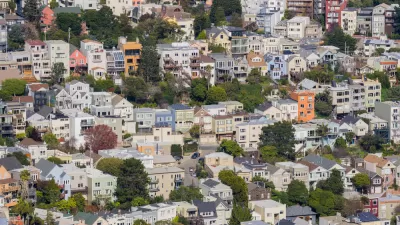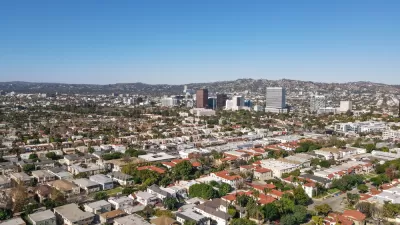The state of California has long looked the other way while cities blocked growth. With the state now enforcing growth plans, more and more cities are faced with losing local control of zoning. Introducing the “Builder's Remedy."

One of the biggest stories in planning anywhere in the country right now is the growing number of California cities that have run afoul of state requirements for the Regional Housing Needs Assessment (RHNA) process, forfeiting local control of zoning approvals in the process and ushering a new planning term that completely upends the planning status quo: the Builder's Remedy.
An article by Liam Dillon for Los Angeles Times sheds new light on the Builder's Remedy, a policy tool that could have pressed local governments to plan for more housing, but went unused until reports about the city of Davis' being among the first in the state to face the consequences of failing the RHNA process. Davis would soon be followed by cities like Santa Monica. Santa Monica would later approve a revised housing plan, bringing the city into compliance, but not before development plans for 4,500 new residential units made it into the development pipeline. The largest city in the state, Los Angeles, avoided the Builder's Remedy by approving a revised Housing Element of the city's General Plan.
“Beverly Hills, Huntington Beach, Malibu, Palm Springs, Pasadena and West Hollywood are among the 124 jurisdictions in Los Angeles, Orange, Riverside, San Bernardino and Imperial counties where the builder’s remedy could be in play because their latest housing plan hasn’t been approved,” report Dillon, citing confirmation from the state Department of Housing and Community Development as evidence. “Coronado, Del Mar and Solana Beach are among 11 cities in San Diego County in the same circumstances. Bay Area cities’ housing plans are due in January.”
Much of Dillon's analysis focuses on Santa Monica, a city with a complicated housing record, passing one of the nation's strongest rent control laws in the 1970s but subsequently allowing little room to grow, and holding basically steady in population as a result.
“In the decades since, regular disputes have erupted over proposals for large housing and commercial developments. Most recently, debates have centered on tearing down a downtown parking garage and replacing it with low-income housing, as well as building a 521-unit apartment building on what’s now a strip mall anchored by a grocery store,” writes Dillon.
With the city only temporarily out of compliance with the RHNA process, Dillon reports that a slow growth organization known as Santa Monica Coalition for a Livable City “is urging the City Council to consider litigation to stop the projects.” Dillon notes that the California Environmental Quality Act (CEQA) is likely to present a sticking point for large projects proposed under the Builder's Remedy. “Additionally, because the builder’s remedy is untested in court, legal questions remain over what developments qualify,” writes Dillon.
FULL STORY: Thousands of apartments may come to Santa Monica, other wealthy cities under little-known law

Study: Maui’s Plan to Convert Vacation Rentals to Long-Term Housing Could Cause Nearly $1 Billion Economic Loss
The plan would reduce visitor accommodation by 25,% resulting in 1,900 jobs lost.

North Texas Transit Leaders Tout Benefits of TOD for Growing Region
At a summit focused on transit-oriented development, policymakers discussed how North Texas’ expanded light rail system can serve as a tool for economic growth.

Using Old Oil and Gas Wells for Green Energy Storage
Penn State researchers have found that repurposing abandoned oil and gas wells for geothermal-assisted compressed-air energy storage can boost efficiency, reduce environmental risks, and support clean energy and job transitions.

Private Donations Propel Early Restoration of Palisades Playground
Los Angeles has secured over $1.3 million in private funding to restore the Pacific Palisades playground months ahead of schedule, creating a modern, accessible space that supports community healing after recent wildfires.

From Blight to Benefit: Early Results From California’s Equitable Cleanup Program
The Equitable Community Revitalization Grant (ECRG) program is reshaping brownfield redevelopment by prioritizing projects in low-income and environmental justice communities, emphasizing equity, transparency, and community benefits.

Planting Relief: Tackling Las Vegas Heat One Tree at a Time
Nevada Plants, a Las Vegas-based nonprofit, is combating the city’s extreme urban heat by giving away trees to residents in underserved neighborhoods, promoting shade, sustainability, and community health.
Urban Design for Planners 1: Software Tools
This six-course series explores essential urban design concepts using open source software and equips planners with the tools they need to participate fully in the urban design process.
Planning for Universal Design
Learn the tools for implementing Universal Design in planning regulations.
Ascent Environmental
Borough of Carlisle
Institute for Housing and Urban Development Studies (IHS)
City of Grandview
Harvard GSD Executive Education
Toledo-Lucas County Plan Commissions
Salt Lake City
NYU Wagner Graduate School of Public Service





























